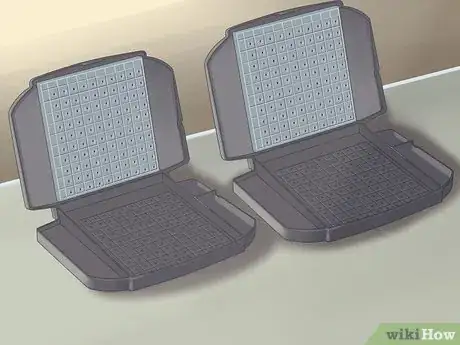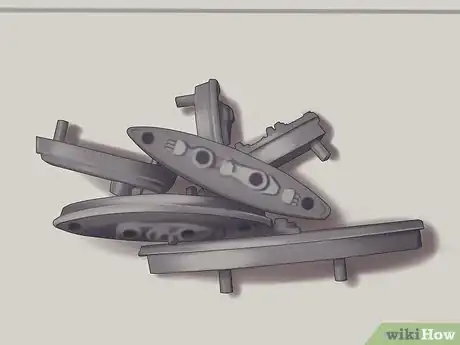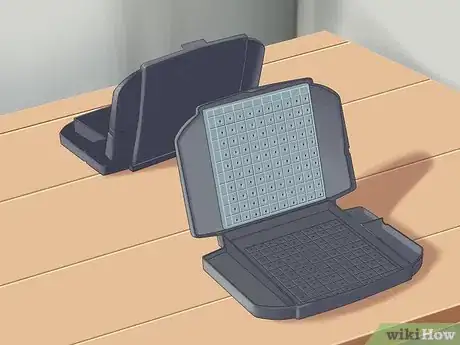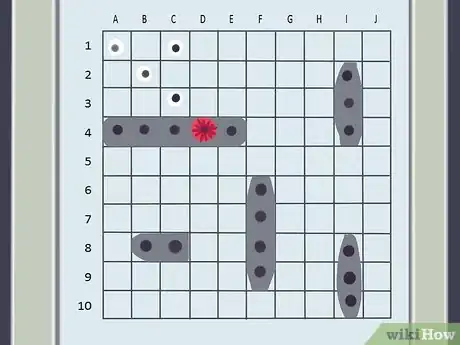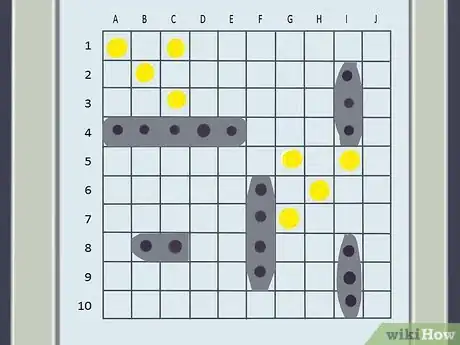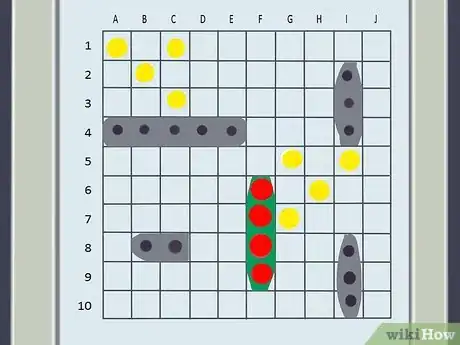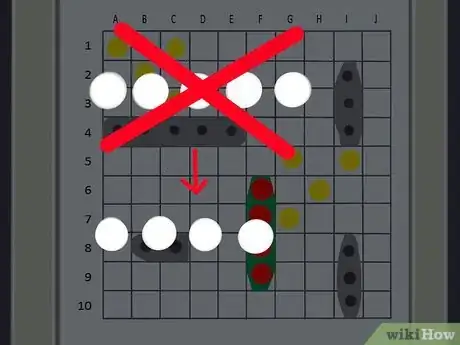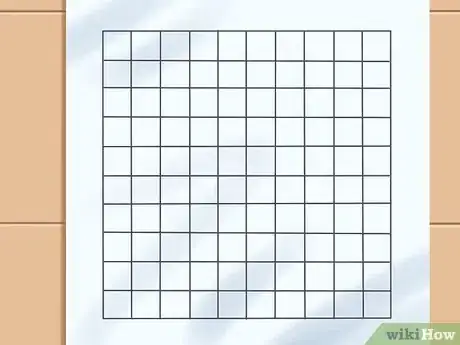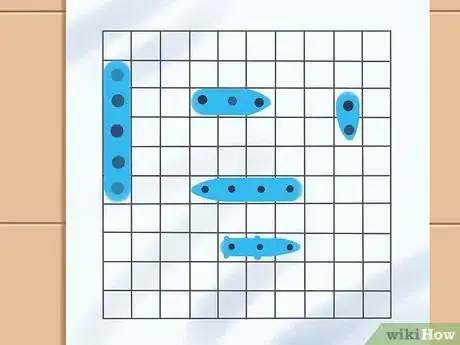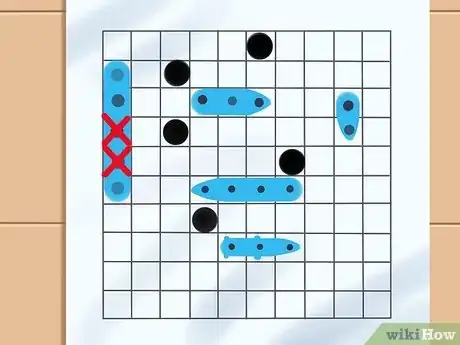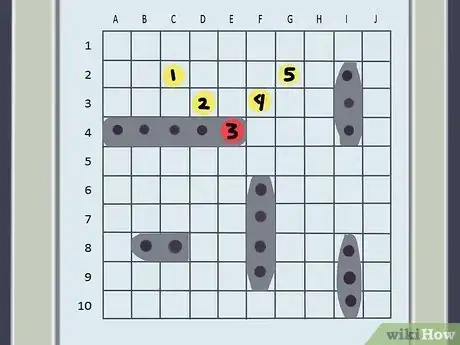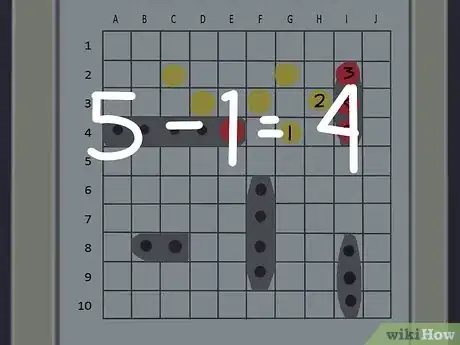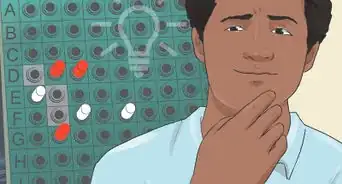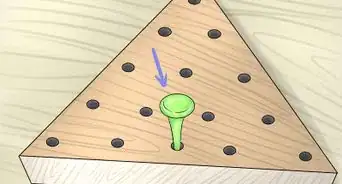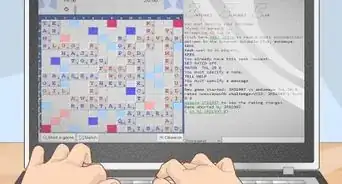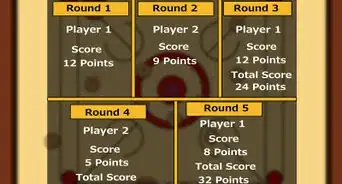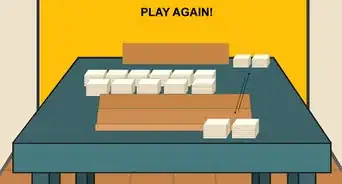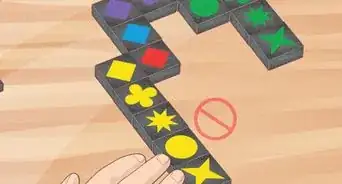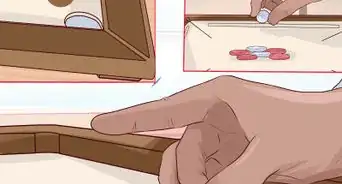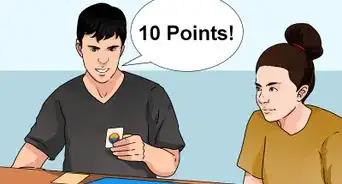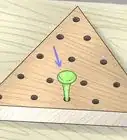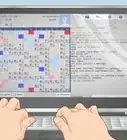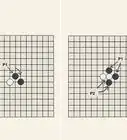wikiHow is a “wiki,” similar to Wikipedia, which means that many of our articles are co-written by multiple authors. To create this article, 30 people, some anonymous, worked to edit and improve it over time.
This article has been viewed 151,664 times.
Learn more...
Battleship has been a popular game for generations. The original pen-and-paper game has inspired multiple board games, handheld electronic versions, computer games, and even a film. Even after all those versions and rule changes however, the game is still simple enough to be played with graph paper and pens. In this article, we’ll teach you the rules for the classic board game and the old-school graph paper version (plus a few twists to make the game more challenging). Stay safe out there on the open seas!
Things You Should Know
- Each player should arrange their ships on the bottom half of their box; do this secretly so that you can’t see each other’s boards.
- To take a “shot,” cite the location on the grid that you’d like to target out loud (i.e. A-1, D-4).
- After a player takes a shot, the other player announces “hit” or “miss” to signal whether their ship was hit or not.
- Use the red and white pegs to track your hits and misses on the upper half of the box; a player wins when they’ve sunk all of their opponent’s ships.
Steps
Game Setup
-
1Give each player a battleship box. The standard Battleship game set comes with two boxes, one for each player. Each box opens to reveal two grids, one on each inside surface.
- If your game set does not include two boxes, plenty of red and white pegs, and at least six ship pieces, it will be difficult to use. Try playing on graph paper instead, as described below, or finding an online version of the game.
-
2Check that all the ship pieces are there. Ships come in various lengths, taking up a different number of squares on the grid. The two players should have identical collections of ships. The following is the typical list, but if you don't have all the pieces, just make sure both sides are even:[1]
- A single ship five squares long (the aircraft carrier)
- A single ship four squares long (the battleship)
- Two ships three squares long (the cruiser and the submarine)
- A single ship two squares long (the destroyer)
Advertisement -
3Have each player secretly arrange their ships. With the boxes open, and the players seated across from each other, each player puts his ships down on the lower grid in front of him. Follow these rules to determine where to put your ships:
- Ships can be placed horizontally or vertically, but not diagonally.
- You must place all five ships on the grid.
- Every ship must be completely on the grid. No ship can hang off the edge of the board.
- Ships cannot overlap each other.
- Once your ships are placed and the game has begun, you are not allowed to move your ships again.
-
4Decide who will play first. If the two players don't agree who should go first right away, flip a coin or decide in some other randomized way. If you are playing multiple games in a row, consider letting the player who lost the last game go first in the next one.
Gameplay & Rules
-
1Learn how to take a shot. Each player uses the upper grid of her box, without any ships placed on it, to keep track of her "shots" at the enemy ships. To take a shot, pick a square on this grid by naming it using the coordinates with the letters on the left and numbers above the grid.
- For example, the square in the top left corner of the grid is named "A-1," since it is in the row labeled A and the column labeled 1.
- To the right of A-1 is A-2, then A-3, etc.
-
2Learn how to respond to an enemy shot. After player 1 announces where she will be "shooting," player 2 checks the same coordinate square on his lower grid, the one with his ships. Player 2 then responds (telling the truth!) one of the following ways:
- If player 1 hit an empty square, without ships, player 2 says "Miss!"
- If player 1 hit a square with a ship in it, player 2 says "Hit!"
- In most "official" rules that come with game sets, the player must also announce which ship was hit (for instance, aircraft carrier).[2] However, many people do not play with this rule.
-
3Keep track of shots as they hit or miss. If player 1 misses with a shot, she puts a white peg into that hole of her upper grid, and player 2 puts a white peg into that hole of his lower grid. If player 1 hits, both players use a red peg instead, with player 2 putting the peg directly into the hole on top of the ship where it was shot.
- You don't need to keep track of your opponent's misses on your own lower grid, if you don't want to. You do need to keep track of your opponent's successful hits, however, so you know when a ship has been sunk.
-
4Announce when each ship gets sunk. If every square of a ship gets shot, that ship is sunk. The player who placed that ship must tell his opponent "You sunk my ___," naming the type of ship that was sunk.
- The names of each ship are listed in the set up section. If you forget them, you can instead say "You sunk the ship with __ squares."
-
5Take turns shooting until one player has lost all their ships. Players alternate taking one shot at a time, whether or not that shot is successful. Whoever manages to sink all of her opponent's ships first wins the game.
Playing on Graph Paper
-
1Outline four 10 x 10 grids. Draw four boxes on the graph paper, each one 10 squares wide and 10 squares long. Have each of the two players take two boxes, labeling one "my ships" and the other "enemy ships."[3]
-
2Draw the outline of your ships on your grid. Hide the box labeled "my ships" from the other player, and draw a thick outline of five ships anywhere within its boundaries. Each ship is one square wide, and ranges in length:
- Draw one ship five squares long (the aircraft carrier)
- Draw one ship four squares long (the battleship)
- Draw two ships three squares long (the cruiser and the submarine)
- Draw one ship two squares long (the destroyer)
-
3Play with the ordinary rules. Use the instructions above to play an ordinary game of Battleship. Instead of using pegs, draw successful hits with Xs and misses with dots, or use any system of symbols you find easy to understand. Use the box labeled "enemy ships" to keep track of the shots you've taken, and the box labeled "my ships" to keep track of your enemy's shots.
Advanced Variations
-
1Try the original "salvo" rules. Once you've played the basic game for a while, you might want to try something a little more challenging. In "Salvo," take your turn by firing five shots at once. The opponent responds as normal, telling you which shots were hits and which were misses, but only after you've selected five squares to aim for.[4] This version of the game was played at least as early as 1931.
-
2Reduce the number of shots you get as you lose ships. Increase the tension, and reward the player who sinks the first ship, by adding this additional rule to the "salvo" rues above. Instead of firing five shots at a time, each player only gets to fire one shot for each surviving ship. For example, if player one loses the cruiser and is down to four ships, player one only gets four shots per turn.
-
3Make the game even harder with advanced salvo rules. Play with the original salvo rules above, but don't tell the opponent exactly which shots were hits or misses. Instead, tell them how many of the shots hit, and how many missed. This results in a complicated game, and is only recommended for advanced players.
- Because you don't know for sure which squares were hits, the ordinary red peg / white peg system probably won't work well for this variation. You may need a pencil and pad of paper for each player, to write down each salvo and the opponent's response.
Community Q&A
-
QuestionHow do I get grid paper?
 Community AnswerYou can buy it at most office supply stores such as Staples, or any other stores that have stationary items. You might even find some at the dollar store. If you have a ruler, you could also just draw grids onto plain paper.
Community AnswerYou can buy it at most office supply stores such as Staples, or any other stores that have stationary items. You might even find some at the dollar store. If you have a ruler, you could also just draw grids onto plain paper. -
QuestionCan I play it with normal A4 sized paper?
 Community AnswerYes, as long as you each know the rules and can play it properly.
Community AnswerYes, as long as you each know the rules and can play it properly. -
QuestionCan I draw the grid myself?
 Community AnswerYes, you can draw your own grid.
Community AnswerYes, you can draw your own grid.
Warnings
- The small pegs may present a choking hazard for children under 3 years old.⧼thumbs_response⧽
Things You'll Need
- Battleship set, or graph paper and pens
- An opponent
References
About This Article
The objective of Battleship is to sink all of your opponent’s ships before they sink yours. To begin, each player grabs a battleship box and secretly arranges their five ships on the lower grid. Every ship must be completely on the grid, and cannot be placed diagonally or overlapping another ship. Once this is done, Player 1 takes a shot. To take a shot, name a square on the upper grid using the letter and number coordinates. For example, the square in the top left corner is A-1, as it is in the row labeled A and the column labeled 1. Player 2 then looks at the coordinates on their lower grid. If the coordinates denote an empty square, Player 2 says “Miss!” Player 1 should put a white peg in their upper grid at the coordinates to show there is nothing there. If the coordinates denote a square with part of a ship on it, Player 2 says “Hit!” Then Player 1 places a red peg in their upper grid at those coordinates, and Player 2 places a red peg on the spot of their ship that was hit. Regardless of whether a shot was a hit or miss, the next player will then take a shot. When every square of a ship gets hit, the player who placed that ship says “You sunk my ship!” The game ends when somebody sinks all of their opponent’s ships. For tips on playing with grid paper instead of the traditional game boxes, read on!
